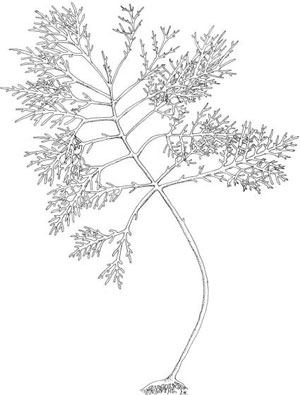Agar
Agar, a general name for polysaccharides extracted from some red algae, is built up of alternating D- and L-galactopyranose units. The name agar is derived from a Malaysian word “agar-agar,” which literally means “macroalgae.” As the gelling agent “kanten,” it is known from Japan since the 17th century; extracts from red macroalgae were carried up the mountains to freeze overnight so that water and other impurities could be extracted from the material. Agar finds its widest use as a
solid microbiological culture substrate. Modern agar is a purified form consisting largely of the neutral fraction known as agarose; the non-ionic nature of the latter makes it more suitable for a range of laboratory applications. Agar in a crude or purified form also finds wide usage in the food industry where it is used in various kinds of ices, canned foods, and bakery products.

FIGURE 7.12 Frond of Gelidium sp.
The higher-quality agar (bacteriological-grade agar) is extracted from species of the red algal genera Pterocladia and Gelidium (Figure 7.12) that are harvested by hand from natural populations in Spain, France, Portugal, Morocco, the Azores, California, Mexico, New Zealand, South Africa, India, Indonesia, the Republic of Korea, Chile, and Japan. Agars of lesser quality are extracted from
Gracilaria and Hypnea species. Food-grade agar is seasonal in Pterocladia species, being low in the colder months and high in the warmer. Gelidium is a small, slow-growing alga and, while efforts to cultivate it in tanks and ponds have been biologically successful, they have generally proved uneconomic. Gracilaria species were once considered unsuitable for agar production because the quality of the agar was poor. In the 1950s, it was found that pre-treatment of the macroalgae with alkali before extraction lowered the yield but gave a good-quality agar. This allowed expansion of the agar industry, which had been previously limited by the available supply of Gelidium, and led to the harvesting of a variety of wild species of Gracilaria in countries such as Argentina, Chile, Indonesia, and Namibia. Chilean Gracilaria was especially useful, but evidence of over-harvesting of the wild crop soon emerged.

FIGURE 7.12 Frond of Gelidium sp.
Cultivation methods were then developed, both in ponds and in the open waters of protected bays. These methods have since spread beyond Chile to other countries, such as China, Indonesia, the Republic of Korea, Namibia, the Philippines and Vietnam, usually using species of Gracilaria native to each particular country. Gracilaria species can be grown in both cold and warm waters. Today, the supply of Gracilaria still derives mainly from the wild, with the extent of cultivation depending on price fluctuations. Agar production is valued at U.S. $132 million annually.





